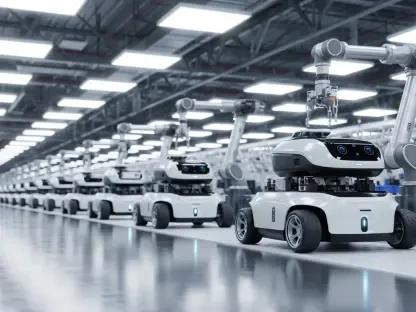Imagine a critical manufacturing plant grinding to a halt because a remote attacker exploited a hidden flaw in its automation software, or an energy grid facing unexpected downtime due to a denial-of-service attack on its control systems. Such scenarios are no longer just theoretical risks but pressing concerns highlighted by recent advisories from the Cybersecurity and Infrastructure Security Agency (CISA). These alerts, targeting vulnerabilities in industrial control systems (ICS) used across sectors like energy, transportation, and commercial facilities, reveal a growing threat landscape. With attackers potentially executing arbitrary code or bypassing authentication, the stakes for securing these systems have never been higher. This discussion delves into the specifics of the newly identified flaws in products from major vendors, the potential impacts on critical infrastructure, and the urgent steps needed to mitigate these risks before they translate into real-world disruptions.
Unveiling Critical Vulnerabilities in ICS Software
Recent advisories from CISA have brought to light severe security flaws in industrial control systems that underpin vital infrastructure worldwide. Specifically, nine vulnerabilities have been identified in software platforms from a prominent automation vendor, affecting tools used for designing and managing human-machine interfaces. These flaws, primarily tied to improper input validation when handling certain file types, carry high severity scores due to their potential for remote code execution. Attackers could exploit these weaknesses by tricking users into interacting with malicious files or compromised websites, leading to unauthorized access or control over critical systems. What’s particularly alarming is the lack of response from the vendor regarding patches or updates, leaving organizations exposed across multiple sectors, including critical manufacturing and energy. This situation underscores a broader challenge in the ICS domain, where delayed or absent vendor support can significantly heighten operational risks.
Adding to the concern, the absence of official remediation for these vulnerabilities forces organizations to rely on alternative safeguards to protect their systems. Without patches, the focus shifts to implementing robust defense-in-depth strategies, such as restricting user interactions with untrusted content and closely monitoring for suspicious activity. The high severity of these flaws, reflected in their elevated risk scores, indicates that even a single successful exploit could disrupt operations or compromise safety in sectors dependent on seamless automation. Affected industries span a wide range, from transportation to information technology, amplifying the urgency for proactive measures. CISA’s guidance emphasizes minimizing exposure to potential attack vectors, but the lack of vendor cooperation complicates the path to security. This scenario serves as a stark reminder that reliance on vendor responsiveness is not always a viable option, pushing organizations to adopt more independent and layered approaches to cybersecurity.
Network-Based Threats in Control Hardware
Another set of critical vulnerabilities targets hardware components integral to industrial automation, specifically controllers and communication modules used in energy and manufacturing environments. A notable flaw in these devices stems from improper input validation, allowing remote attackers to trigger denial-of-service conditions through specially crafted network commands. With a high severity score due to its accessibility over networks, this issue poses a direct threat to operational continuity, as affected systems could be rendered unusable during an attack. Fortunately, the vendor has released firmware updates for some of the impacted components, though applying these fixes often requires system reboots, which can be disruptive in live environments. This advisory highlights the fragility of network-connected ICS hardware and the cascading effects that even temporary downtime can have on critical infrastructure.
Beyond the immediate risk of downtime, the broader implications of these network-based vulnerabilities reveal a troubling trend in industrial systems. As more control hardware becomes interconnected to enable remote monitoring and management, the attack surface expands, offering malicious actors additional entry points. The ability to exploit such flaws without physical access to the systems underscores the importance of securing network perimeters and segmenting critical components from external exposure. While firmware updates provide a partial solution, the logistical challenges of implementing them without interrupting operations add another layer of complexity. CISA recommends complementing patches with measures like firewall deployment and VPN-secured access to reduce the likelihood of exploitation. This dual approach of remediation and prevention is crucial for sectors where even brief disruptions can lead to significant financial or safety consequences, emphasizing the need for comprehensive cybersecurity planning.
Authentication and Control Risks in Specialized Systems
A separate advisory focuses on vulnerabilities in specialized refrigeration controllers used primarily in commercial facilities, exposing risks such as authentication bypass and command injection. These flaws, discovered through dedicated research efforts, allow attackers to gain unauthorized access or execute arbitrary code after breaching initial defenses, with additional issues potentially causing denial-of-service conditions. While the complexity of exploiting these vulnerabilities somewhat mitigates immediate threats, their impact on systems controlling environmental conditions in critical facilities remains significant. The vendor has issued updates to address these issues, providing a pathway to secure affected systems, though deployment must be prioritized to prevent potential disruptions in temperature-sensitive operations. This case illustrates the diverse nature of ICS vulnerabilities, extending beyond traditional manufacturing into niche applications.
The implications of these flaws extend to the operational integrity of facilities reliant on precise environmental controls, where unauthorized access or system downtime could compromise safety and efficiency. Even with updates available, the challenge lies in ensuring timely application across potentially large and distributed networks of devices. CISA’s recommendations include adopting layered security practices, such as network segmentation and strict access controls, to limit the risk of exploitation even before updates are fully rolled out. The varying attack complexity associated with these vulnerabilities suggests that while not all systems face imminent danger, the potential for targeted attacks by skilled adversaries remains a concern. This advisory serves as a critical reminder that ICS security must account for specialized equipment, often overlooked in broader cybersecurity strategies, to protect against unique and potentially devastating threats.
Strengthening Defenses Against Emerging Threats
Reflecting on the insights from recent CISA advisories, it becomes evident that industrial control systems face substantial risks from a range of vulnerabilities, from software flaws to hardware weaknesses. The varying responses from vendors, with some providing timely patches while others remain silent, highlight an uneven landscape of risk management that organizations must navigate. High severity scores associated with many of these flaws underscore the potential for significant operational impacts, whether through remote code execution or system downtime. Looking ahead, the path to resilience lies in prioritizing immediate patching where possible and embedding robust defense-in-depth strategies to cover gaps left by unresponsive vendors. Adopting measures like network segmentation, continuous monitoring, and restricted access protocols can serve as vital safeguards. As threats evolve, staying proactive with cybersecurity practices will be essential to protect critical infrastructure from the next wave of exploits waiting to emerge.









